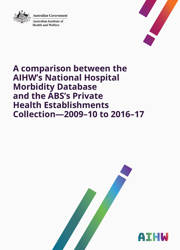A comparison between the AIHW's National Hospital Morbidity Database and the ABS's Private Health Establishments Collection: 2009–10 to 2016–17
Citation
AIHW
Australian Institute of Health and Welfare (2020) A comparison between the AIHW's National Hospital Morbidity Database and the ABS's Private Health Establishments Collection: 2009–10 to 2016–17, AIHW, Australian Government, accessed 06 May 2024.
APA
Australian Institute of Health and Welfare. (2020). A comparison between the AIHW's National Hospital Morbidity Database and the ABS's Private Health Establishments Collection: 2009–10 to 2016–17. Canberra: AIHW.
MLA
Australian Institute of Health and Welfare. A comparison between the AIHW's National Hospital Morbidity Database and the ABS's Private Health Establishments Collection: 2009–10 to 2016–17. AIHW, 2020.
Vancouver
Australian Institute of Health and Welfare. A comparison between the AIHW's National Hospital Morbidity Database and the ABS's Private Health Establishments Collection: 2009–10 to 2016–17. Canberra: AIHW; 2020.
Harvard
Australian Institute of Health and Welfare 2020, A comparison between the AIHW's National Hospital Morbidity Database and the ABS's Private Health Establishments Collection: 2009–10 to 2016–17, AIHW, Canberra.
PDF | 795Kb
Between 2009–10 and 2016–17, the number of private hospital admitted patient care separations reported through the Private Health Establishments Collection were consistently higher than those reported through the National Hospital Morbidity Database.
- ISBN: 978-1-76054-667-0
- Cat. no: HSE 241
- Pages: 58
-
The PHEC rose from 3.7% higher than the NHMD in 2009–10 to 10.5% higher in 2016–17
-
The most significant discrepancies between the PHEC and the NHMD occurred for private free-standing day facilities
-
In 2016–17 PHEC separations for private free-standing day facilities were 29.8% higher than for the NHMD
-
In 2016–17 PHEC separations for Other private hospitals were 5.2% higher than for the NHMD



